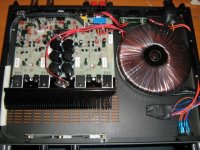Hi,
I just bought a very cheap amplifier fromr thomann.de, a t.amp S75. Although it seems to be good value for the money at first (torroid transformer, good connectors, etc.), it sounds terrible at low volumes. The level of distortion is unaccpeptable, even having low demands.
The reason for that was quickly identified: An idle current at the output transistors was simple not existing, thus leding to excessive switching distorions. It is not possible to raise the voltage between the driving transitors to a level that would cause an idle current (approx. 4x0.7V) in the original configuration, even with the trimmer full clockwise. So I shunted a 10k resisor in parallel with the existing 2k resistor near the idle current trimmer (both, the 200 Ohm trimmer and the 2k resistor are between base and emiter of the small "virtual zener-diode" that defines the bias voltage between the dirves bases) which increased the bias voltage range about 20 percent.
This allows to set the bias current to a reasonable value. I chose 10mA. The switching distortions disappeart.
Hope, this helps other S75 owners...
Cheers,
Hering
I just bought a very cheap amplifier fromr thomann.de, a t.amp S75. Although it seems to be good value for the money at first (torroid transformer, good connectors, etc.), it sounds terrible at low volumes. The level of distortion is unaccpeptable, even having low demands.
The reason for that was quickly identified: An idle current at the output transistors was simple not existing, thus leding to excessive switching distorions. It is not possible to raise the voltage between the driving transitors to a level that would cause an idle current (approx. 4x0.7V) in the original configuration, even with the trimmer full clockwise. So I shunted a 10k resisor in parallel with the existing 2k resistor near the idle current trimmer (both, the 200 Ohm trimmer and the 2k resistor are between base and emiter of the small "virtual zener-diode" that defines the bias voltage between the dirves bases) which increased the bias voltage range about 20 percent.
This allows to set the bias current to a reasonable value. I chose 10mA. The switching distortions disappeart.
Hope, this helps other S75 owners...
Cheers,
Hering
Servus hering,
Can you tell us more of the internal? What power transistors are in there, etc.... Pictures would be great too!
Thanks,
Markus
Can you tell us more of the internal? What power transistors are in there, etc.... Pictures would be great too!
Thanks,
Markus
hmm, this ones height is 1HE...
I think for an amp to mod, a E400 or E600 would be the better start.
I think for an amp to mod, a E400 or E600 would be the better start.
You are right of course but I wanted 1U due to limited space.
Anyway, the mods will be in electronics arount input mostly so no bulky parts like psu filter caps and xformer will get involved.
Anyway, the mods will be in electronics arount input mostly so no bulky parts like psu filter caps and xformer will get involved.
Any news?
Did you try some mods in the mean time? Does the increased bias current improve the sound?
I have the same unit, a lot of parts for the money, good build quality.
I don't hear distortions but the sound is a bit boring and it hums slightly.
Could be interesting for active speakers if modding can solve above issues.
Does somebody have the schematics?
Joe
Did you try some mods in the mean time? Does the increased bias current improve the sound?
I have the same unit, a lot of parts for the money, good build quality.
I don't hear distortions but the sound is a bit boring and it hums slightly.
Could be interesting for active speakers if modding can solve above issues.
Does somebody have the schematics?
Joe
- Status
- Not open for further replies.
- Home
- Amplifiers
- Solid State
- the t.amp S75 bias modification
